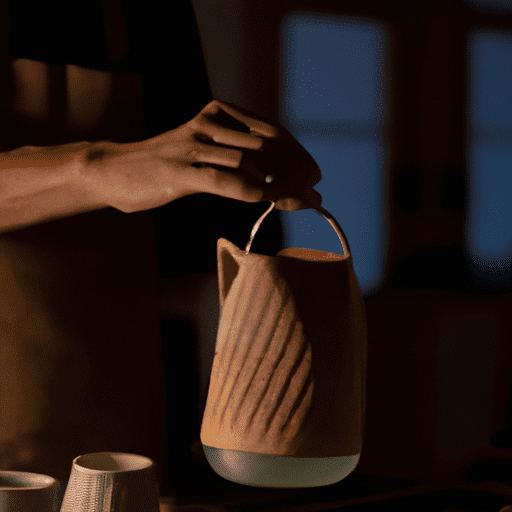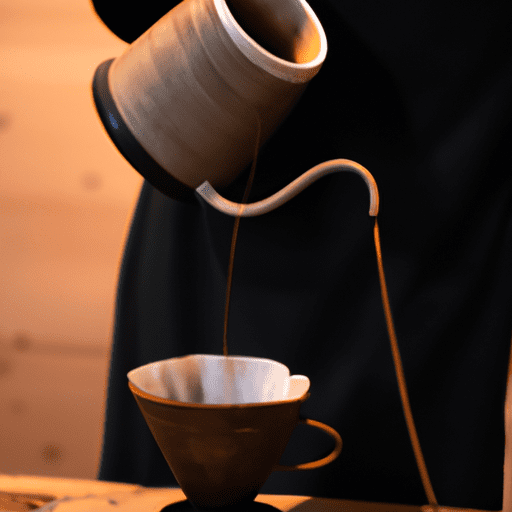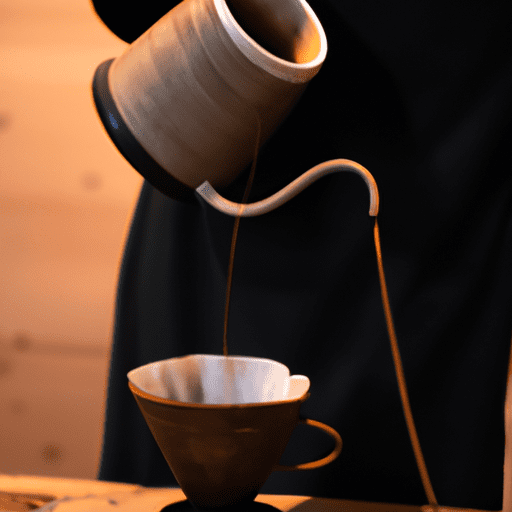Ready to elevate your morning routine? Let’s guide you on an exploration of the wholesome experience of pour over coffee like you’ve never tasted before! This article will share insights on how to masterfully prepare pour over coffee using a Japanese ceramic maker, showcasing a fusion of elegant design, artisan craft, and exceptional flavor. Get set to immerse yourself in the subtle techniques, precise timing, and meticulous attention to detail involved, which marry to create the delectable taste and aroma of your morning brew.

Choosing the Right Japanese Ceramic Pour Over Coffee Maker
Drinking coffee is not just about consuming a beverage, it’s about enjoying a whole experience. Part of that experience is the process of brewing your coffee. However, this process can feel incomplete without the right tools, especially a great coffee maker. If you’re as passionate about coffee as we are, you may love exploring the traditional art of making pour-over coffee with a Japanese ceramic coffee maker. In this section, we offer tips on how to choose the right ceramic pour over coffee maker.
Consider the Material
Japanese ceramics are renowned for their unique aesthetic properties. Beyond that, the material of your coffee maker significantly affects the taste of your brew. Ceramic coffee makers retain heat exceptionally well. This keeps the water at the correct temperature longer, offering a consistent extraction rate throughout the brewing process, and in turn, a richer taste. While choosing the material, also keep in mind to opt for a coffee maker with a lead-free glaze to ensure the safest brewing experience.
Evaluate the Design
Beyond just the material, the design of the coffee maker also plays a markedly significant role. Japanese ceramic coffee makers come in manifold designs, each with a varying degree of influence on your brew. Generally, a maker with spiral ridges on the inner surface is preferred because these ridges allow the water to flow in a specific pattern aiding in extracting the optimal flavor from the beans.
Selecting the Size and Capacity
The size and capacity of your coffee maker should be chosen based on your personal needs. If you typically brew coffee for multiple people, a larger coffee maker would be more suitable. Conversely, if you generally make coffee for one or two people, a smaller ceramic coffee maker will do the trick.
Preparing Your Japanese Ceramic Pour Over Coffee Maker
Just like any fine art, making a perfect cup of coffee requires some preparation. Here, we walk you through the process of preparing your ceramic coffee maker for the perfect brew.
Gathering the Equipment
Before you start brewing your coffee, you need to ensure you have all the necessary equipment. Alongside your ceramic coffee maker, you will need a burr grinder, a gooseneck kettle, a scale, a timer, and of course, some high-quality coffee beans.
Cleaning and Seasoning the Ceramic
Before using your ceramic coffee maker for the first time, always ensure that it’s clean. Rinse it with hot water to remove any ceramic dust or residue. Seasoning your ceramic by pouring a bit of your coffee grounds and hot water before brewing will help to get rid of any lingering ceramic flavor.
Choosing the Right Coffee Beans
The coffee beans you choose will directly impact the flavor of your brew. When selecting a coffee bean, consider its roast date, origin, and variety. A freshly roasted bean often gives the most robust flavor.
Mastering the Pour Over Coffee Technique
Now that your coffee maker is ready, it’s time for the brewing process. Here’s a step-by-step guide on mastering the pour-over coffee technique.
Grinding the Coffee Beans
Grinding your beans just before brewing will offer the freshest and richest taste. The grind size should be medium-fine, similar to the consistency of sea salt.
Measuring the Coffee and Water
A typical ratio for pour-over coffee is 1:17 (coffee to water). However, you can tweak this according to your personal taste. A digital scale can help ensure a precise ratio.
Pre-Infusion
Pre-infusion is the process of wetting the coffee grounds to let them release carbon dioxide. In this step, pour enough water to just cover the grounds and let them bloom for about 30 seconds.

Brewing Tips for a Perfect Cup
Like any art, there aren’t strict rules in coffee brewing. However, understanding the basic factors affecting the taste will help you to brew a better cup.
Water Temperature and Quality
The recommended water temperature for the pour-over method is between 195°F and 205°F. Also, using filtered water can majorly improve the quality of your coffee because it minimizes any unwanted flavors in the water.
Controlling Brew Time
The pour-over brewing method typically takes between 3 to 5 minutes. Brewing your coffee for too long can make it overly bitter while brewing for a shorter time can make it taste weak.
Maintaining a Consistent Pour
Maintain a consistent and slow pour for an even extraction. A gooseneck kettle can help in controlling the flow and direction of the water.
Exploring Different Pour Over Brewing Methods
There are a few different methods in pour-over brewing. In this section, we discuss the three popular ones.
Classic V60 Method
The V60 method earned its name from the V-shaped cone that has a 60-degree angle. The V60 method allows the coffee to flow into a single-point below, emphasizing the distinct flavors of the bean.
Kalita Wave Method
As the name suggests, the Kalita Wave has a flat bottom design with three small holes. This design allows for a longer extraction time, resulting in a fuller body and more balanced flavor.
Bee House Dripper Method
The Bee House method uses a wedge-shaped cone with two holes at the bottom. This method is perfect for beginners as it calls for less meticulous measurement and methods and still produces a great cup of coffee.
Enhancing the Coffee Flavor with Japanese Ceramics
The material of your coffee maker can affect the taste of your coffee. Let’s explore how Japanese ceramics can enhance the flavor of your coffee.
Understanding Ceramic Properties
Ceramic is a great insulator, which means it holds heat exceptionally well. Hence, it keeps the water at an ideal brewing temperature ultimately resulting in a richer and more flavorful cup of coffee.
Benefits of Using Japanese Ceramic
Japanese ceramics are known for their high quality and beautiful designs. The craftsmanship put into these ceramic coffee makers can make your coffee brewing process a more enjoyable experience.
How Ceramic Affects Coffee Taste
The small pores in the ceramic material allow for a slight flow of air during the brewing process. This airflow can enhance the aroma and taste of the coffee.
Caring for Your Japanese Ceramic Pour Over Coffee Maker
To prolong the life of your coffee maker and maintain the quality of your brew, it’s crucial to properly care for your ceramics.
Regular Cleaning and Maintenance
Cleaning your ceramic coffee maker after each use is necessary to prevent oil and residue buildup. Use warm water and gentle soap to clean it. Avoid using any harsh cleaning tools as they can damage the ceramic.
Avoiding Common Mistakes
Never put your ceramic maker on a hot stove or in a microwave as it can cause cracks. Also, avoid pouring cold water immediately after using hot water, as this significant temperature change can damage the ceramic.
Storing the Ceramic Properly
Store your ceramic coffee maker in a safe place to avoid knocks or drops. It’s best to keep it at room temperature.
Finding the Perfect Coffee Pairings
Coffee pairing is an art in itself. It’s about enhancing the flavors of the food and the coffee.
Understanding Coffee Flavor Profiles
Coffee has a variety of flavor profiles, from fruity to floral, from nutty to chocolatey. Understanding the flavor profile of your coffee is the first step in finding the perfect pairing.
Matching Coffee with Food
Once you understand the flavor profile of your coffee, you can then match it with food. For example, fruity coffees pair well with pastries and sweets, while nutty or chocolatey coffees go great with rich foods like brownies or cheesecake.
Exploring Different Coffee Origins
Another exciting aspect of coffee pairing is exploring coffees from different origins. Each coffee region has a distinct flavor, and trying them with different foods can be a fun culinary adventure.
Experimenting with Pour Over Brewing Techniques
Don’t be afraid to experiment a bit with your brewing. Changing a few variables can significantly affect the taste of your brew.
Adjusting Grind Size and Coffee-to-Water Ratio
Adjusting the grind size or the coffee-to-water ratio can change the strength and flavor of your brew. Finer grinds tend to yield stronger coffee, and a higher coffee-to-water ratio makes a more potent cup.
Exploring Brewing Time Variations
Playing around with the brewing time can lead to discovering new flavors. Brewing for a shorter or longer time can bring out different notes from the beans.
Trying Different Pouring Techniques
Changing your pouring technique can affect the extraction and consequently the taste of your brew. Pouring slower or faster, pouring in a certain pattern, or stirring during the brew can all alter the taste of your coffee.
Japanese Ceramic Pour Over Coffee Maker Recommendations
Choosing the right coffee maker can be overwhelming with so many choices out there. Here are some of our recommendations.
Top Japanese Ceramic Pour Over Brands
Hario and Kalita are arguably the top Japanese brands for ceramic coffee makers. They offer high-quality products with beautiful designs.
Budget-Friendly Options
If you’re on a tight budget, brands like Melitta and Bee House offer functional and affordable ceramic coffee makers.
Ceramics for Travel
If you’re a frequent traveler, the Snow Peak Collapsible Coffee Drip and the GSI Outdoors Ceramic Dripper are compact yet durable options. These coffee makers are specifically designed to be easily packed and transported.
In conclusion, mastering the art of pour-over coffee with a Japanese ceramic coffee maker is a rewarding skill. Not only will you be able to brew a fantastic cup of coffee, but you’ll also get to enjoy the process and make it part of your daily ritual. So, take the plunge and explore the exciting world of pour-over coffee brewing. It’s an excellent journey for any coffee lover!
